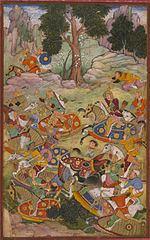User:Kansas Bear/Battle of Panipat
This article needs additional citations for verification. (May 2011) |
| First Battle of Panipat | |||||||||
|---|---|---|---|---|---|---|---|---|---|
| Part of Mughal conquests | |||||||||
 The battle of Panipat and the death of Sultan Ibrāhīm | |||||||||
| |||||||||
| Belligerents | |||||||||
|
| Lodi dynasty | ||||||||
| Commanders and leaders | |||||||||
|
|
Ibrahim Lodi† Raja Hasan Khan Mewattpati | ||||||||
| Strength | |||||||||
|
13,000-15,000 Mughals[1] field artillery |
30,000-40,000 [1] 100-1,000 war elephants[2] | ||||||||
| Casualties and losses | |||||||||
| Few | 15,000-20,000 [1] | ||||||||
First Battle of Panipat was fought between the invading forces of Babur and the Lodi Empire, which took place on 21 April 1526 in North India. It marked the beginning of the Mughal Empire. This was one of the earliest battles involving gunpowder firearms and field artillery.[3]
Details
[edit]
In 1526, the Mughal forces of Babur, the Timurid ruler of Kabulistan, defeated the much larger ruling army of Ibrahim Lodi, Sultan of Delhi.
Background
[edit]The battle was fought on 7 April near the small village of Panipat (now an industrial town in Haryana), in the present day Indian state of Haryana, an area that has been the site of a number of decisive battles for the control of Northern India since the twelfth century.
It is estimated that Babur's forces numbered around 15,000 men and had between 20 to 24 pieces of field artillery. Babur estimated Lodi had around 100,000 men, though that number included camp followers, while the fighting force was around 30,000 to 40,000 men in total, along with at least 1000 war elephants.[1]
Battle
[edit]Hearing of the size of Ibrahim's army, Babur secured his right flank against the city of Panipat, while digging a trench covered with tree branches to secure his left flank. In the center, he placed 700 carts tied together with ropes, between every two carts there were breastworks for his matchlockmen. Babur also ensured there was enough space for his cavalry to charge through these carts.[5]
When Ibrahim's army arrived, he found the approach to Babur's army to narrow to attack. While adjusting his forces to allow for the narrower front, Babur quickly took advantage of the situation to flank(tulghuma) the Lodi army.[6] Faced with musket fire, cannon fire and cavalry attacks from all sides, Ibrahim Lodi fought and died with 6000 of his remaining troops.[7]
Advantage of cannons in the battle
[edit]Babur's guns proved decisive in battle, firstly because Ibrahim Lodi lacked any field artillery, but also because the sound of the cannon frightened Lodi's elephants, causing them to trample Lodi's own men.[8]
Tactics
[edit]New tactics introduced by Babur were the tulghuma and the araba. Tulghuma meant dividing the whole army into various units, viz. the Left, the Right and the Centre. The Left and Right divisions were further subdivided into Forward and Rear divisions. Through this a small army could be used to surround the enemy from all the sides. the Centre Forward division was then provided with carts (araba) which were placed in rows facing the enemy and tied to each other with animal hide ropes. Behind them were placed cannons protected and supported by mantelets which could be used to easily manoeuvre the cannons. These two tactics made Babur's artillery lethal. The guns and cannons could be fired without any fear of being hit as they were shielded by the bullock carts which were held in place due to the hide ropes holding them together. the nozzle of the heavy cannons could also be easily changed as they could be manoeuvered by the mantelets which were provided with wheels.
Aftermath
[edit]Ibrahim Lodi died on the field of battle along with 15,000 of his troops. Vikramajit, ruler of Gwaliyar was killed as well.[9] The battle of Panipat was militarily a decisive victory, however, politically it gained Babur little and initiated a new phase of his establishment of the Mughal empire.[10]
References
[edit]- ^ a b c d (Davis 1999, pp. 181 & 183) Cite error: The named reference "Davis" was defined multiple times with different content (see the help page).
- ^ (Davis 1999, p. 181 & 183)
- ^ Romesh C. Butalia, The Evolution of the Artillery in India: From the Battle of Plassey to the Revolt of 1857, (Allied Publishing Limited, 1998), 16.
- ^ Satish Chandra, Medieval India:From Sultanat to the Mughals, Vol. 2, (Har-Anand, 2009), 27.
- ^ Satish Chandra, Medieval India:From Sultanat to the Mughals, Vol. 2, 29.
- ^ Satish Chandra, Medieval India:From Sultanat to the Mughals, Vol. 2, 30.
- ^ Satish Chandra, Medieval India:From Sultanat to the Mughals, Vol. 2, 30.
- ^ Battles of Panipat, Tim J. Watts, Conflict and Conquest in the Islamic World: A Historical Encyclopedia, ed. Alexander Mikaberidze, (ABC-CLIO, 2011), 707.
- ^ Satish Chandra, Medieval India:From Sultanat to the Mughals, Vol. 2, 30.
- ^ Satish Chandra, Medieval India:From Sultanat to the Mughals, Vol. 2, 30-31.
Sources
[edit]- Davis, Paul K. (1999), 100 Decisive Battles: From Ancient Times to the Present, Oxford University Press, ISBN 1-57607-075-1
